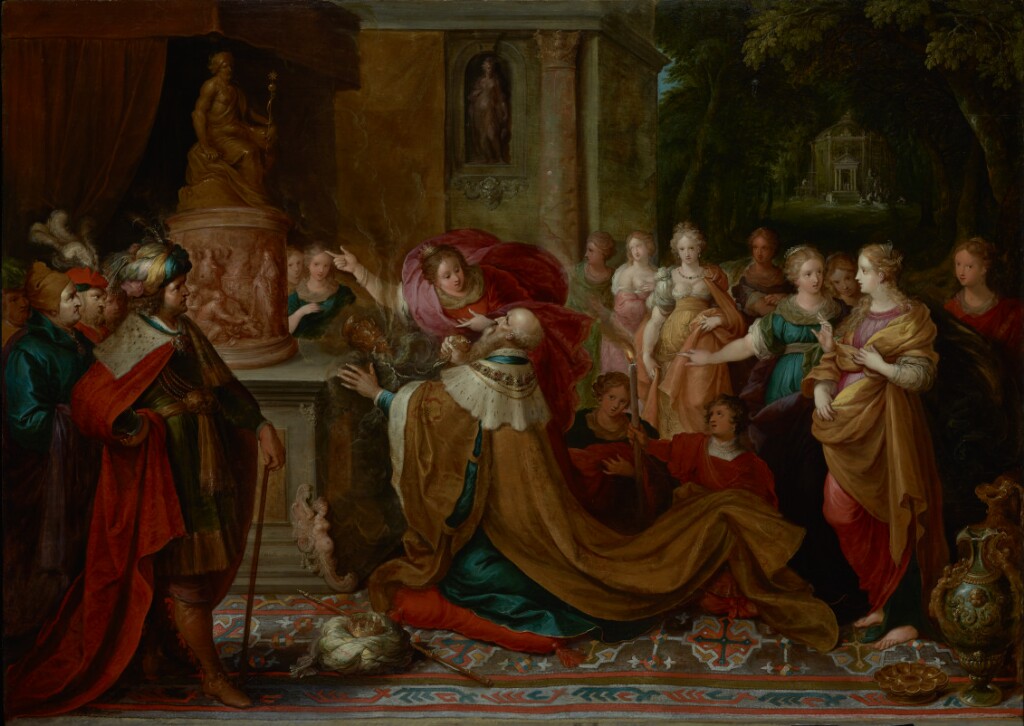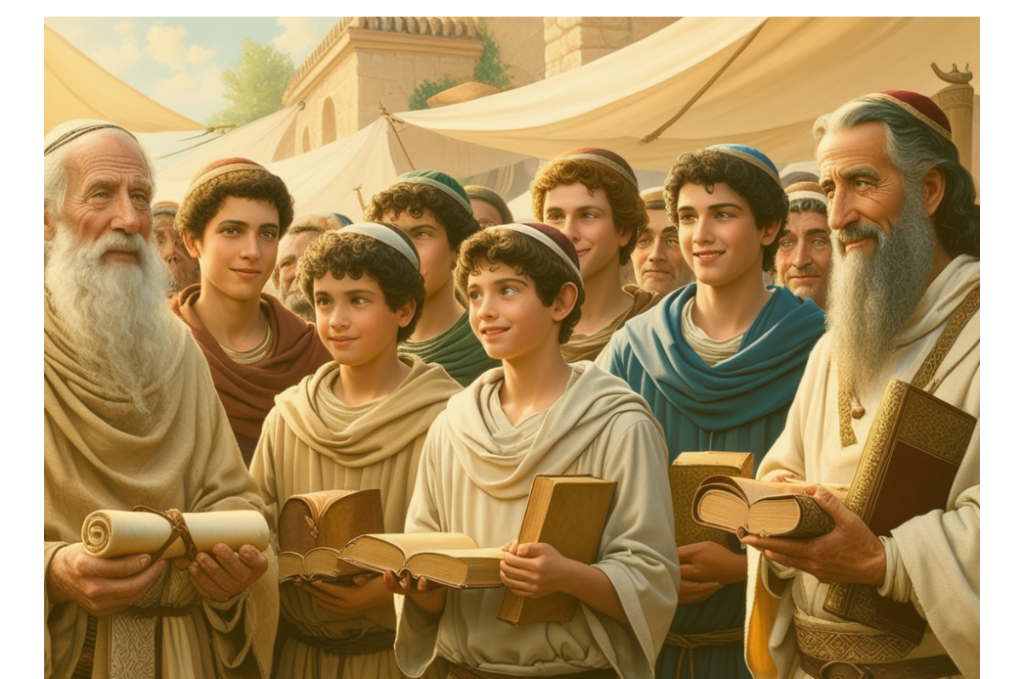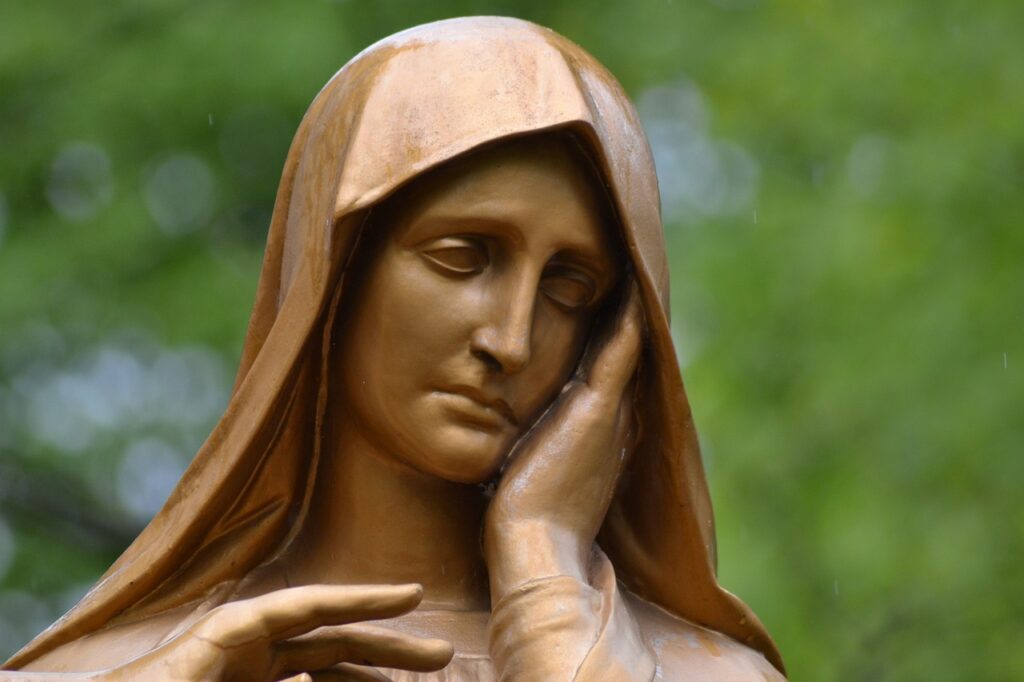Featured Art : “Solomon’s Idolatry” by Frans Francken the Younger, a depiction of King Solomon worshipping foreign gods, influenced by his foreign wives, as described in the Book of 1 Kings 11:1-8.
What Is Idolatry?
Idolatry is the practice of ascribing divine qualities or ultimate worth to things or beings that are not God. This is fundamentally different from veneration, which acknowledges the significance of individuals without attributing divine status. In Catholic theology, the veneration of Mary is distinct from the worship of God.
The Catholic Position On Mary
Catholics hold two distinctive respects towards honoring someone. These can be categorized as, Veneration (Dulia) and Worship (Latria).
Catholics honor Mary with a form of reverence, or veneration, known as “hyperdulia,” which is higher than the reverence given to saints but still distinct from the worship due to God alone. This distinction is important: veneration acknowledges Mary’s unique role in salvation history but does not equate her with divine status. Worship or “latria” is reserved for God alone. Catholics are careful to avoid any confusion between the honor given to Mary and the worship given to God. The distinction between veneration and worship is central to Catholic practice and teaching.
What Is The Role Of Mary Then?
To Catholics, Mary is honored as the Mother of God, The New Eve, The Ark of the New Covenant, Queen Mother and Queen of Heaven. ( If this doesn’t sit well with you, please see “Why is Mary so special?”) This unique role makes her a central figure in the story of salvation. Her veneration is based on her role and her exemplary faith and obedience to God. The earliest Christians realized this and have done so since the 2nd and 3rd centuries. This is nothing newly developed. ( If you are not comfortable with this please see the post – “Why Mary is so special?”).
The practice of veneration reflects a belief in the communion of saints, where saints, including Mary, are seen as intercessors who pray for the faithful. Protestants often define idolatry as the worship of anything other than God, including the worship of saints, images, or any created thing. This definition is based on the commandment in Exodus 20:4-5, which prohibits making and worshiping idols.
Some Protestants view Catholic veneration of Mary and the saints as problematic because it appears to elevate them to a status that might resemble worship. They argue that such practices can detract from the sole worship of God.
However, if one views Marian veneration as idolatrous, they must also view the veneration of the Ark of the Old Covenant in the scriptures as idolatrous, given the similar roles they play in religious life.
Let’s compare.
Old Ark V.S New Ark
Marian veneration in Catholicism shares some similarities with how the Israelites treated the Ark of the Covenant in the Bible, particularly in how both are revered as important symbols and vessels of God’s presence and power, though with significant differences in theology and practice.
The Ark of the Covenant was the most sacred object in Israelite worship, representing the very presence of God among His people.
It contained the tablets of the Ten Commandments, Aaron’s rod, and manna, which were direct symbols of God’s covenant with Israel. The Israelites believed that God’s presence dwelled above the Ark, particularly in the Holy of Holies in the Tabernacle and later in the Temple.
In Catholic theology, Mary is referred to as the “New Ark of the Covenant” because she bore Jesus Christ, the Word of God, in her womb. Just as the Ark carried the covenantal items that represented God’s presence, Mary carried God Himself in the person of Jesus. This parallel elevates Mary’s role, making her a sacred vessel chosen by God, and thus worthy of special veneration.
How the Ark of the Covenant Was Treated:
1. Both are believed to do Miracles
The Ark was associated with miraculous events, such as the parting of the Jordan River (Joshua 3:14-17) and the fall of Jericho (Joshua 6:6-20).
Marian apparitions and miracles (e.g., Lourdes, Fatima) are attributed to her intercession.
2. Both have a Central Role in Devotion to God
The Ark was central in Israelite worship; it was placed in the Holy of Holies, where God’s presence was believed to dwell (Exodus 25:21-22).
Mary is central in Catholic devotion, especially through prayers like the Rosary and feast days. Catholics believe she intercedes for the faithful before God.
3. Central in Processions
The Ark was carried in processions (Joshua 6:4-5) and was present when the Israelites sought God’s favor in battle (1 Samuel 4:3-4).
Mary is honored in Marian processions, where statues or icons are carried in processions as symbols of her presence and intercession. Catholics pray to Mary for her intercession in times of need. These processions are meant to express reverence and honor for Mary’s role in salvation history, much like the processions of the Ark were expressions of reverence for God’s presence among the Israelites.
4. Praying Before the Ark/Mary
Jacob prayed before the Ark (Exodus 32:7-11), believing in God’s presence there.
In the same manner Catholics pray before statues or images of Mary, believing she intercedes on their behalf before God.
Both Serve as a Symbol of God’s Covenant.
5. The Ark symbolized God’s covenant with Israel; Mary is seen as the Ark of the New Covenant through Christ
The Ark was a symbol of God’s covenant with Israel and a reminder of His promises and His law. It was a physical representation of God’s enduring presence and faithfulness to His people.
Mary is venerated as a symbol of the new covenant in Christ. She is seen as the first and most perfect disciple, whose “yes” to God made the incarnation of Jesus possible. Just as the Ark was central to the old covenant, Mary is central to the new covenant as the mother of the Redeemer.
6. Both Are Seen as Channels of Blessing
The Ark brought blessings to the house of Obed-Edom; Mary is believed to bring blessings through her intercession.
7. Both are Called Holy
If protestants are concerned over the fact that Catholics call Mary Holy, by claiming only god is Holy, then it might come as a surprise the Bible calls the Ark Holy.
1) 2 Samuel 6:2*
“And David arose and went with all the people who were with him from Baale-judah to bring up from there the ark of God, which is called by the Name, the name of the Lord Almighty, who is enthroned between the cherubim on the ark.” This passage emphasizes that the Ark is associated with the very name and presence of God, highlighting its sacredness.
2) 1 Chronicles 16:29
“Ascribe to the Lord the glory due his name; bring an offering and come before him! Worship the Lord in the splendor of holiness.”
While this verse directly speaks about worshiping God, it is in the context of bringing the Ark into Jerusalem and establishing proper worship, thus linking the Ark with God’s holiness.
3) Psalm 99:5
– “Exalt the Lord our God; worship at his footstool! Holy is he!”
– The “footstool” is a reference to the Ark of the Covenant (see 1 Chronicles 28:2), which was considered the footstool of God’s throne, reinforcing its holiness.
4. Joshua 3:3-4
– “When you see the ark of the covenant of the Lord your God, and the priests, who are Levites, carrying it, you are to move out from your positions and follow it. Then you will know which way to go, since you have never been this way before. But keep a distance of about two thousand cubits between you and the ark; do not go near it.”
The command to keep a distance from the Ark underscores its sacredness and the reverence required in its presence.
5) 2 Chronicles 35:3
“And he said to the Levites who taught all Israel and who were holy to the Lord, ‘Put the holy ark in the house that Solomon the son of David, king of Israel, built. You need not carry it on your shoulders. Now serve the Lord your God and his people Israel.’“
I mean need I say more?
Conclusion
The use of religious images and relics in Catholicism may be seen as problematic by some Protestants who believe that such practices might lead to the veneration of created objects rather than focusing solely on God. Protestants often emphasize a direct personal relationship with God through Jesus Christ, without intermediary figures such as saints or Mary. They may see the use of such intermediaries as unnecessary or even contrary to the teachings of the New Testament. However its important to understand the importance of the blessed virgin in the Christian faith. Protestant theologian and priest John Stott said in his book The Cross of Christ, “We need to come daily to the Scriptures and to sit like Mary at Jesus’ feet, listening to his Word.” This is exactly the perspective Mary holds for Catholics.
So I pose the question, one accepts the Ark’s reverence as a legitimate expression of faith, it is inconsistent and hypocritical to reject Marian veneration on the grounds of idolatry. To say Marian veneration is idolatrous, you must also think the veneration toward the Ark of the Covenant is idolatrous. Both are expressions of deep reverence and honor for what they represent: God’s presence through sacred symbols.
Just as the Ark was the place where God’s presence dwelled among the Israelites, Mary is the new Ark of the Covenant, carrying the presence of God in her womb. To reject Marian veneration is to misunderstand the significance of the Old Testament Ark and its role in salvation history. Catholics veneration is not idolatry , they simply see her as the most significant and holy human being who ever lived, much like the Israelites honored the Ark as the most sacred object in their religious life.
Catholics nor Israelites worship these entities themselves but honor what they symbolize.



